Solar Impulse
Solar Impulse is a Swiss long-range experimental solar-powered aircraft project, and also the name of the project's two operational aircraft.[2] The privately financed project is led by Swiss engineer and businessman André Borschberg and Swiss psychiatrist and balloonist Bertrand Piccard, who co-piloted Breitling Orbiter 3, the first balloon to circle the world non-stop.[3] The Solar Impulse project's goals were to make the first circumnavigation of the Earth by a piloted fixed-wing aircraft using only solar power and to bring attention to clean technologies.[4]
| Solar Impulse | |
|---|---|
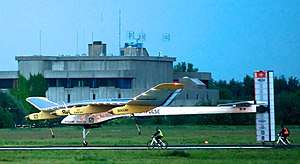 | |
| Solar Impulse 1 landing at Brussels Airport after its first international flight on 13 May 2011. | |
| Role | Experimental solar-powered aircraft |
| National origin | Switzerland |
| Manufacturer | Solar Impulse |
| First flight | 3 December 2009 |
| Primary user | André Borschberg and Bertrand Piccard |
| Produced | 2009–present |
| Number built | 2 (including prototype) |
| Program cost | $170 million[1] |
The aircraft is a single-seated monoplane powered by photovoltaic cells; it is capable of taking off under its own power. The prototype, often referred to as Solar Impulse 1, was designed to remain airborne up to 36 hours.[5] It conducted its first test flight in December 2009. In July 2010, it flew an entire diurnal solar cycle, including nearly nine hours of night flying, in a 26-hour flight.[6] Piccard and Borschberg completed successful solar-powered flights from Switzerland to Spain and then Morocco in 2012,[7] and conducted a multi-stage flight across the US in 2013.[8][9]
A second aircraft, completed in 2014 and named Solar Impulse 2, carries more solar cells and more powerful motors, among other improvements. On 9 March 2015, Piccard and Borschberg began to circumnavigate the globe with Solar Impulse 2, departing from Abu Dhabi in the United Arab Emirates.[10] The aircraft was scheduled to return to Abu Dhabi in August 2015 after a multi-stage journey around the world.[11] By June 2015, the plane had traversed Asia,[12] and in July 2015, it completed the longest leg of its journey, from Japan to Hawaii.[13] During that leg, the aircraft's batteries sustained thermal damage that took months to repair.[14] Solar Impulse 2 resumed the circumnavigation in April 2016, when it flew to California.[15][16] It continued across the US until it reached New York City in June 2016.[17] Later that month, the aircraft crossed the Atlantic Ocean to Spain.[18] It stopped in Egypt[19] before returning to Abu Dhabi on 26 July 2016, more than 16 months after it had left, completing the approximately 42,000-kilometre (26,000-mile) first circumnavigation of the Earth by a piloted fixed-wing aircraft using only solar power.[20]
Project development and funding
Bertrand Piccard initiated the Solar Impulse project in November 2003 after undertaking a feasibility study in partnership with the École Polytechnique Fédérale de Lausanne.[21] As a mechanical engineer, co-founder André Borschberg directed the construction of each aircraft and oversees the preparation of the flight missions.[22] By 2009, they had assembled a multi-disciplinary team of 50 engineers and technical specialists from six countries, assisted by about 100 outside advisers and 80 technological partners.[23][24]
The project is financed by a number of private companies and individuals, as well as receiving around CHF 6 million (US$6.4 million) in funding from the Swiss government.[25] The project's private financial backers include Omega SA, Solvay, Schindler, ABB[26] and Peter Diamandis.[27] The EPFL, the European Space Agency and Dassault have provided technical expertise, while SunPower provided the aircraft's photovoltaic cells.[28][29]
Piccard stated that the entire project from its beginnings in 2003 until mid-2015 had cost €150 million.[30] It raised another €20 million in late 2015 to continue the round-the-world flight.[31]
Timeline
- 2002[32]: Feasibility study at the École Polytechnique Fédérale de Lausanne
- 2004–2005: Development of the concept
- 2006: Simulation of long-haul flights
- 2006–09: Construction of first prototype (HB-SIA; Solar Impulse 1)
- 2009: First flight of Solar Impulse 1
- 2009–11: Manned test flights[33]
- 2011–12: Further test flights through Europe and North Africa
- 2011–13: Construction of second prototype (HB-SIB; Solar Impulse 2)
- 2013: Continental flight across the US by Solar Impulse 1[2][8][9]
- 2014: First flight of Solar Impulse 2
- 2015–2016: Circumnavigation of the Earth by Solar Impulse 2, conducted in seventeen stages over 16-1/2 months[20]
Solar Impulse 1 (HB-SIA)
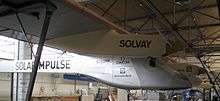

The first Solar Impulse aircraft, registered as HB-SIA, was primarily designed as a demonstration aircraft. It has a non-pressurized cockpit and a single wing with a wingspan similar to that of the Airbus A340 airliner. Under the wing are four nacelles, each with a set of lithium polymer batteries, a 10 hp (7.5 kW) electric motor and one twin-bladed propeller. To keep the wing as light as possible, a customised carbon fibre honeycomb sandwich structure was used.[34] 11,628 photovoltaic cells on the upper wing surface and the horizontal stabilizer generate electricity during the day to power the electric motors and to charge the batteries allowing flight at night, theoretically enabling the single-seat plane to stay in the air indefinitely.[35][36]
The aircraft's major design constraint is the capacity of the lithium polymer batteries. Over an optimum 24-hour cycle, the motors can deliver a combined average of about 8 hp (6 kW), roughly the power used by the Wright brothers' Flyer, the first successful powered aircraft, in 1903.[34] In addition to the charge stored in its batteries, the aircraft uses the potential energy of height gained during the day to power its night flights.[37]
Specifications
Data from Solar Impulse Project[34] and Diaz[38]
General characteristics
- Crew: 1
- Length: 21.85 m (71.7 ft)
- Wingspan: 63.4 m (208 ft)
- Height: 6.40 m (21.0 ft)
- Wing area: 11,628 photovoltaic cells rated at 45 kW peak: 200 m2 (2,200 sq ft)
- Aspect ratio: 19.7
- Loaded weight: 1,600 kg (3,500 lb)
- Max. takeoff weight: 2,000 kg (4,400 lb)
- Take-off speed: 35 kilometres per hour (22 mph)
- Powerplant: 4 × electric motors, 4 x 21 kWh lithium-ion batteries (450 kg (990 lb)), providing 7.5 kW (10 HP) each
- Propeller diameter: 3.5 m at 200 to 400 rpm (11 ft)
Performance
- Cruise speed: 70 kilometres per hour (43 mph)
- Endurance: approximately 36 hours
- Service ceiling: 8,500 m (27,900 ft) with a maximum altitude of 12,000 metres (39,000 ft)
Operational history
Maiden flight and other early flights
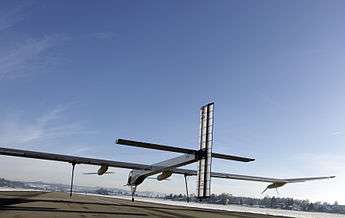
On 26 June 2009, Solar Impulse 1 was first presented to the public at the Dübendorf Air Base, Switzerland. Following taxi testing, a short-hop test flight was made on 3 December 2009,[39] piloted by Markus Scherdel.[40] Borschberg, co-leader of the project team, said of the flight:
"It was an unbelievable day. The airplane flew for about 350 metres (1,150 ft) and about 1 metre (3 ft 3 in) above the ground ... The aim was not to get high but to land on the same runway at a speed to test its controllability and get a first feeling of its flying characteristics ... the craft behaved just as the engineers had hoped. It is the end of the engineering phase and the start of the flight testing phase."[40]
On 7 April 2010, the plane conducted an 87-minute test flight, piloted by Markus Scherdel. This flight reached an altitude of 1,200 m (3,937 ft).[41][42] On 28 May 2010, the aircraft made its first flight powered entirely by solar energy, charging its batteries in flight.[43]
First overnight flight
On 8 July 2010, Solar Impulse 1 achieved the world's first manned 26-hour solar-powered flight.[44][45][46] The airplane was flown by Borschberg, and took off at 6:51 a.m. Central European Summer Time (UTC+2) on 7 July from Payerne Air Base, Switzerland. It returned for a landing the following morning at 9:00 a.m. local time.[47] During the flight, the plane reached a maximum altitude of 8,700 m (28,500 ft).[48] At the time, the flight was the longest and highest ever flown by a manned solar-powered aircraft; these records were officially recognized by the Fédération Aéronautique Internationale (FAI) in October 2010.[49][50]
International and intranational flights
Belgium and France (2011)
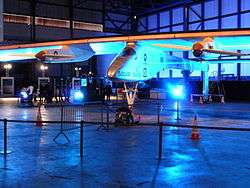
On 13 May 2011 at 21:30 local time, the plane landed at Brussels Airport, after completing a 13-hour flight from its home base in Switzerland. It was the first international flight by the Solar Impulse, which flew at an average altitude of 6,000 ft (1,800 m) for a distance of 630 km (391 mi), with an average speed of 50 km/h (31 mph). The aircraft's slow cruising speed required operating at a mid-altitude, allowing much faster air traffic to be routed around it.[51] The aircraft was piloted by Borschberg. The project's other co-founder, Piccard, said in an interview after the landing: "Our goal is to create a revolution in the minds of people...to promote solar energies – not necessarily a revolution in aviation."[52][53]
A second international flight to the Paris Air Show was attempted on 12 June 2011, but the plane turned back and returned to Brussels because of adverse weather conditions.[54] In a second attempt on 14 June, Borschberg successfully landed the aircraft at Paris' Le Bourget Airport after a 16-hour flight.[55]
First intercontinental flight (2012)
On 5 June 2012, the Solar Impulse successfully completed its first intercontinental flight, a 19-hour trip from Madrid, Spain, to Rabat, Morocco.[7] During the first leg of the flight from Payerne Air Base to Madrid, the aircraft broke several further records for solar flight, including the longest solar-powered flight between pre-declared waypoints (1,099.3 km (683 mi)) and along a course (1,116 km (693 mi)).[56]
United States (2013)
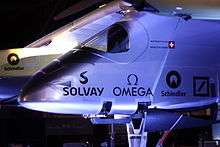
On 3 May 2013, the plane began its cross-US flight with a journey from Moffett Field in Mountain View, California, to Phoenix Goodyear Airport in Arizona. Successive legs of the flight ended at Dallas-Fort Worth airport, Lambert–St. Louis International Airport,[57] Cincinnati Municipal Lunken Airport to change pilots and avoid strong winds,[58] and Washington Dulles International Airport.[59] On 6 July 2013, following a lengthy layover in Washington, Solar Impulse completed its cross-country journey, landing at New York City's JFK International Airport at 11:09 p.m. EDT.[9][60] The landing occurred three hours earlier than originally intended, because a planned flyby of the Statue of Liberty was cancelled as a result of damage to the covering on the left wing.[9]
Each flight leg took between 14 and 22 hours.[8][61] The aircraft's second leg of its trip on 23 May to Dallas-Fort Worth covered 1,541 kilometres (958 mi) and set several new world distance records in solar aviation.[62] Solar Impulse 1 was placed on public display at JFK after its landing. In August 2013, it was disassembled, then transported via a Cargolux B-747-400F to Dübendorf Air Base, where it was placed in storage in a hangar.
- Detailed route
Source:[63]
| Leg | Start[64] | Stop | Origin | Destination | Distance | Flight time | Avg. speed | Pilot |
|---|---|---|---|---|---|---|---|---|
| 1 | 3 May 14:12 | 4 May 08:30 | Moffett Field, California (KNUQ) | Phoenix, Arizona (KGYR) | 984 km | 18 hrs 18 mins | 53 km/h | Bertrand Piccard |
| 2 | 22 May 12:47 | 23 May 07:08 | Phoenix, Arizona (KGYR) | Dallas, Texas (KDFW) | 1541 km | 18 hrs 21 mins | 84 km/h | André Borschberg |
| 3 | 3 Jun 10:06 | 4 Jun 07:28 | Dallas, Texas (KDFW) | Saint Louis, Missouri (KSTL) | 1040 km | 21 hrs 22 mins | 49 km/h | Bertrand Piccard |
| 4 | 14 Jun 11:01 | 15 Jun 02:15 | Saint Louis, Missouri (KSTL) | Cincinnati, Ohio (KLUK) | 15 hrs 14 mins | André Borschberg | ||
| 5 | 15 Jun 15:10 | 16 Jun 05:15 | Cincinnati, Ohio (KLUK) | Washington, DC (KIAD) | 14 hrs 5 mins | Bertrand Piccard | ||
| 6 | 6 July 09:56 | 7 July 05:15 | Washington, DC (KIAD) | New York City, New York (KJFK) | 19 hrs 19 mins | André Borschberg | ||
Aircraft on display
In March 2015, the plane was transported by truck to Paris to be part of the permanent exhibition at Cité des Sciences et de l'Industrie.[65]
Solar Impulse 2 (HB-SIB)
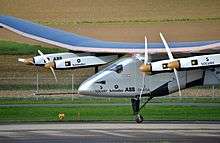
Construction history
Construction started in 2011 on the second aircraft, known as Solar Impulse 2, which carries the Swiss registration HB-SIB. Completion was initially planned for 2013, with a 25-day circumnavigation of the globe planned for 2014. A structural failure occurred on the aircraft's main spar during static tests in July 2012, leading to delays in the flight testing schedule to allow repairs. Solar Impulse 2's first flight took place at Payerne Air Base on 2 June 2014.[66]
Design
The wingspan of Solar Impulse 2 is 71.9 m (236 ft), slightly less than that of an Airbus A380, the world's largest passenger airliner,[38] but compared with the 500-ton A380,[67] the carbon-fibre Solar Impulse weighs only about 2.3 tonnes (5,100 lb), little more than an average SUV.[68] It features a non-pressurized cockpit 3.8 cubic metres (130 cu ft) in size[69] and advanced avionics, including limited functionality of an autopilot that allows the pilot to sleep for up to 20 minutes at a time,[70] enabling multi-day transcontinental and trans-oceanic flights.[23] Supplemental oxygen and various other environmental support systems allow the pilot to cruise up to an altitude of 12,000 metres (39,000 ft).[38]
Specifications
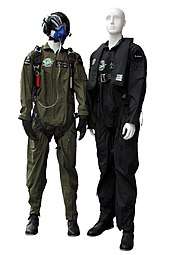
Data from Solar Impulse Project[24]
General characteristics
- Crew: 1
- Length: 22.4 m (73.5 ft)
- Wingspan: 71.9 m (236 ft)
- Height: 6.37 m (20.9 ft)
- Wing area: 17,248 photovoltaic solar cells cover the top of the wings, fuselage and tailplane for a total area of 269.5 m2 (2,901 sq ft) (rated at 66 kW peak)
- Take-off speed: 36 km/h (22.4 mph)
- Powerplant: 4 × electric motors, 4 x 41 kWh lithium-ion batteries (633 kg (1,396 lb)), providing 13 kW[33] (17.4 hp) each
- Propeller diameter: 4 m (13.1 ft)
Performance
- Maximum speed: 140 km/h (87 mph)
- Cruise speed: 90 km/h (56 mph) 60 km/h (37 mph) at night to save power
- Service ceiling: 8,500 m (27,900 ft) with a maximum altitude of 12,000 metres (39,000 ft)
Operational history
Solar Impulse 2 was first publicly displayed on 9 April 2014.[24] Its inaugural flight took place on 2 June 2014, piloted by Markus Scherdel.[71] The aircraft averaged a ground speed of 30 knots (56 km/h), and reached an altitude of 5,500 feet (1,700 m).[72] The first night flight was completed on 26 October 2014, and the aircraft reached its maximum altitude during a flight on 28 October 2014.
2015–16 circumnavigation of the Earth
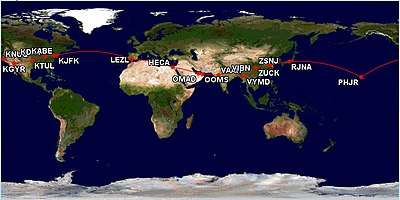
The repair work to the aircraft's main spar delayed Solar Impulse 2's circumnavigation of the Earth from 2012 to 2015.[73] The aircraft was delivered to Masdar City in Abu Dhabi for the World Future Energy Summit in late January 2015,[74] and it began the journey from Al Bateen Executive Airport on 9 March 2015.[10][75] It was scheduled to return to the same location in August 2015.[11][76] A mission control centre for the circumnavigation was established in Monaco, using satellite links to gather real-time flight telemetry and remain in constant contact with the aircraft and the support team.[77]
The route followed by Solar Impulse 2 was entirely in the Northern Hemisphere. It left Abu Dhabi, then it headed east to nearby Oman and India.[76][78] Twelve stops were originally planned along the route, with pilots Borschberg and Piccard alternating; at each stop, the crew awaited good weather conditions along the next leg of the route.[79] For most of its time airborne, Solar Impulse 2 cruised at a ground speed of between 50 and 100 kilometres per hour (31 and 62 mph), usually at the slower end of that range at night to save power. Legs of the flight crossing the Pacific and Atlantic oceans were the longest stages of the circumnavigation, taking up to five days and nights.[11][80] On multi-day flights, the pilots took 20-minute naps and used yoga or other exercises to promote blood flow and maintain alertness.[69]
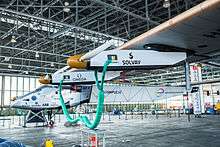
By the end of May 2015, the plane had traversed Asia.[81] It made an unscheduled stop in Japan to await favourable weather over the Pacific, increasing the expected number of legs of the journey to 13.[12][82] The aircraft began the flight from Japan to Hawaii on 28 June 2015 (29 June, Japan local time).[83] With Borschberg in the cockpit, it reached Hawaii on 3 July, setting new records for the world's longest solar-powered flight both by time (117 hours, 52 minutes) and distance (7,212 km; 4,481 mi). The flight's duration was also a record for longest solo flight, by time, for any aircraft.[13][84][85] During that leg the plane's batteries were damaged by overheating because they were packed in too much insulation. New parts had to be ordered, and as it was late in the season, with days shortening in the northern hemisphere, the plane was grounded in Hawaii. The US Department of Transportation stored the aircraft in a hangar at Kalaeloa Airport on Oahu.[86][87]
New batteries were made and installed in the plane. Test flights began in February 2016[88] to prepare for resumption of the circumnavigation once northern hemisphere days lengthened enough to permit multi-day solar-powered flights.[14][31] A favourable weather window opened in April 2016, and the plane resumed its journey,[15][89] landing at Moffett Field, in California, on 23 April.[16] During that flight, Piccard, via a live videolink, spoke with Ban Ki-Moon and Doris Leuthard before the General Assembly of the United Nations, from the cockpit of Solar Impulse 2, commenting on that day's historic signing of the Paris Agreement and discussing how using clean technologies can create jobs and fight global warming.[90] Additional legs of the flight were added in the US as Solar Impulse 2 flew to Phoenix, Arizona,[91][92] Tulsa, Oklahoma,[93] Dayton, Ohio,[94] Lehigh Valley, Pennsylvania[95] and New York City, arriving there on 11 June 2016.[17]
Piccard piloted the aircraft across the Atlantic Ocean, arriving in Seville, Spain, on 23 June.[18] The aircraft next stopped in Cairo, Egypt, on 13 July,[19] and landed in Abu Dhabi on 26 July, completing the around-the-world trip in a total of 17 stages and 16-1/2 months; it was the first circumnavigation of the Earth by a piloted fixed-wing aircraft using only solar power.[20]
Detailed route
| Leg | Start[96] | Origin | Destination | Flight time | Distance | Avg. speed | Max. altitude | Pilot |
|---|---|---|---|---|---|---|---|---|
| 1 | 9 March 2015 03:12 | 13 hrs 1 min | 417 nmi (772 km) | 32.0 kn (59.2 km/h) | 20,942 ft (6,383 m) | A. Borschberg[97] | ||
| 2 | 10 March 02:35 | 15 hrs 20 mins | 860 nmi (1,593 km)[98] | 56.1 kn (103.9 km/h) | 29,114 ft (8,874 m) | B. Piccard[99] | ||
| 3 | 18 March 01:48 | 13 hrs 15 mins | 630 nmi (1,170 km) | 47.7 kn (88.3 km/h) | 17,001 ft (5,182 m) | Borschberg[100] | ||
| 4 | 18 March 23:52 | 13 hrs 29 mins | 829 nmi (1,536 km) | 61.5 kn (113.9 km/h) | 27,000 ft (8,230 m) | Piccard[101] | ||
| 5 | 29 March 21:06 | 20 hrs 29 mins | 883 nmi (1,636 km) | 43.1 kn (79.9 km/h) | 28,327 ft (8,634 m) | Piccard[102] | ||
| 6 | 20 April 22:06 | 17 hrs 22 mins | 747 nmi (1,384 km) | 43.0 kn (79.7 km/h) | 14,010 ft (4,270 m) | Piccard[103] | ||
| 7 | 30 May 18:39 | 44 hrs 9 mins | 1,589 nmi (2,942 km) | 36.0 kn (66.6 km/h) | 28,327 ft (8,634 m) | Borschberg[12][104] | ||
| 8 | 28 June 18:03 | 117 hrs 52 mins | 4,819 nmi (8,924 km) | 40.9 kn (75.7 km/h) | 28,327 ft (8,634 m) | Borschberg[84][105] | ||
| 9 | 21 April 2016 16:15 | 62 hrs 29 mins | 2,206 nmi (4,086 km) | 35.3 kn (65.4 km/h) | 28,327 ft (8,634 m) | Piccard[15][106] | ||
| 10 | 2 May 12:03 | 15 hrs 52 mins | 601 nmi (1,113 km) | 37.9 kn (70.2 km/h) | 22,001 ft (6,706 m) | Borschberg[107] | ||
| 11 | 12 May 11:05 | 18 hrs 10 mins | 850 nmi (1,570 km) | 46.7 kn (86.4 km/h) | 22,001 ft (6,706 m) | Piccard[108] | ||
| 12 | 21 May 09:22 | 16 hrs 34 mins | 647 nmi (1,199 km) | 39.1 kn (72.4 km/h) | 21,001 ft (6,401 m) | Borschberg[109] | ||
| 13 | 25 May 08:02 | 16 hrs 49 mins | 564 nmi (1,044 km) | 33.6 kn (62.2 km/h) | 15,000 ft (4,572 m) | Piccard[110] | ||
| 14 | 11 June 03:18 | 4 hrs 41 mins | 143 nmi (265 km) | 30.6 kn (56.6 km/h) | 3,002 ft (915 m) | Borschberg[111] | ||
| 15 | 20 June 06:30 | 71 hrs 8 mins | 3,653 nmi (6,765 km) | 50.9 kn (94.3 km/h) | 27,999 ft (8,534 m) | Piccard[112] | ||
| 16 | 11 July 04:20 | 48 hrs 50 mins | 2,022 nmi (3,745 km) | 41.4 kn (76.7 km/h) | 27,999 ft (8,534 m) | Borschberg[113] | ||
| 17 | 23 July 2016 23:28 | 48 hrs 37 mins | 1,455 nmi (2,694 km) | 29.9 kn (55.4 km/h) | 27,999 ft (8,534 m) | Piccard[114] | ||
| Total | 558 hrs 7 mins (23.25 days) |
22,915 nmi (42,438 km) | 41.0 kn (76.0 km/h) | 29,114 ft (8,874 m) |
- Notes:
Honours
In 2016, the Swiss Post edited a special stamp to honour the achievement of Solar Impulse 2.[115]
Future projects
World Alliance for Clean Technologies
During the final flight before the completion of their circumnavigation of the globe, Borschberg and Piccard announced the creation of a World Alliance for Clean Technologies (later renamed World Alliance for Efficient Solutions). The aim of this non-governmental organisation is to promote green energy and sustainable technologies.[116][117] World Alliance was launched in November 2017.[118]
Future unmanned solar aircraft project
The Solar Impulse team plans to develop an unmanned solar-powered aircraft that can fly continuously at high altitudes to carry out some of the work currently performed by satellites and that will also be able to "run applications" that cannot currently be performed by satellites, in such fields as communication, measurements and observations for agriculture, infrastructure planning and other purposes.[117] Borschberg predicted in 2016: "In three years we will have the first prototypes flying".[119]
By November 2019, the Solar Impulse 2 was being converted as an unmanned aircraft in Castilla-La Mancha in Spain for U.S. startup Skydweller Aero, backed by Leonardo and other investors, and formed by UAV experts from Northrop Grumman. It is offered for ISR and for position, navigation and timing; as a communications relay and industrial geospatial sensing. It could carry 300–800 lb (140–360 kg) payload up to 45,000 ft (14 km) up to 90 days, and supply 2 kW of power: much more than fragile but higher HAPS. It could operate year-round within latitudes of ±20°, from spring to fall within ±40°, and year-round at high latitudes, with an optional backup hydrogen fuel cell with reduced endurance. Powerful apertures at medium altitudes can provide better coverage than a small-capacity stratospheric aircraft. For aerial surveying, higher payloads with more power at lower altitudes results in higher-resolution imagery. The aircraft could carry the same sensors as the General Atomics MQ-1C or MQ-9. Built for EASA CS-23 certification, it should fly for the first time in 2020 and initial production is targeted for late 2021.[120]
See also
- Electric aircraft
- List of circumnavigations
- Solar vehicle
- Renewable energy by country
- Other solar aircraft
- Gossamer Penguin
- Helios Prototype
- Qinetiq Zephyr
- Solar Challenger
- PlanetSolar, first solar vehicle (boat) to circumnavigate the Earth
- SolarStratos
- Records
Notes and references
- Piccard, Bertrand (11 July 2016). "How to raise $170 million for a crazy idea".
- Cardwell, Diane (1 May 2013). "Cross-Country Solar Plane Expedition Set for Takeoff". The New York Times. Retrieved 2 May 2013.
- "A Speck in the Sky". The New York Times. 21 March 1999. Retrieved 24 June 2013.
- Div, Stav. "Solar Impulse 2: The groundbreaking aircraft demonstrating the possibilities of clean energy", The Independent, 2 June 2016
- "HB-SIA Mission". Solar Impulse Project. Archived from the original on 26 July 2011. Retrieved 5 December 2009.
- "Swiss solar plane makes history with night flight". Swisster. 8 July 2010. Retrieved 13 July 2010.
- "Solar plane completes maiden intercontinental trip". Reuters. 5 June 2012. Retrieved 6 June 2012.
- "Across America". Solar Impulse. 2013. Archived from the original on 29 June 2013. Retrieved 13 June 2013.
- "Solar Impulse ends cross-country US flight slightly early in NY due to torn left wing". Engadget. 6 July 2013. Retrieved 7 July 2013.
- Batrawy, Aya (9 March 2015). "Solar-powered plane takes off for flight around the world". Associated Press. Retrieved 14 March 2015.
- Al Wasmi, Naser (25 September 2014). "Pilots to take off from Abu Dhabi for historic solar-powered flight". The National. Retrieved 7 January 2015.
- "Leg 7: Nanjing to Nagoya", Solar Impulse. Retrieved 29 July 2015; "Solar Impulse touches down on unscheduled Japan stop", The Sun Daily (Malaysia), 2 June 2015
- Archangel, Amber."Solar Impulse Sets World Record: 117 Hours & 52 Minutes – Longest Solo Flight Ever". cleantechnica.com. 6 July 2015.
- Al Wasmi, Naser. "After months-long hiatus, Solar Impulse 2 gets set to fly again", The National, 11 March 2016
- Amos, Jonathan (21 April 2016). "Solar Impulse sets off for California after long lay-off". BBC.
- Berger, Noah. "Solar-powered plane completes journey across Pacific Ocean" Archived 7 May 2016 at the Wayback Machine, The Charlotte Observer, 24 April 2016
- Rice, Doyle. "Solar Impulse 2 lands in New York City, final U.S. destination", USA Today, 11 June 2016
- Amos, Jonathan. "Solar Impulse completes Atlantic crossing with landing in Seville", BBC, 23 June 2016
- Amos, Jonathan. "Solar Impulse: Zero-fuel plane lands in Cairo", BBC News, 13 July 2016
- "Solar Impulse completes historic round-the-world trip", BBC News, 26 July 2016
- "What happened between 2001 and 2003?". Solar Impulse. 31 December 2003. Archived from the original on 20 August 2013.
- "Can solar power fuel future flight". CNN. 29 November 2011. Retrieved 29 November 2011.
- "Major steps". Solar Impulse. Archived from the original on 15 September 2012. Retrieved 5 December 2009.
- "Building a Solar Airplane" Archived 13 April 2014 at the Wayback Machine. Solar Impulse. Retrieved 19 January 2015.
- "Government supports Solar Impulse with CHF6m". SwissInfo.ch. 18 February 2015. Retrieved 24 March 2015.
- Piccard, Bertrand (4 April 2014). "Solar Impulse gets a lift!". Archived from the original on 17 July 2014. Retrieved 4 April 2014.
- Dijakovic, Viktoria (10 October 2013). "Peter Diamandis our New Patron". Solar Impulse. Archived from the original on 16 December 2014. Retrieved 22 March 2015.
- "Solar Impulse – Around the world in a solar airplane". SunPower. Archived from the original on 3 May 2012. Retrieved 24 January 2013.; and Dijakovic, Viktoria (17 July 2012). "Construction HB-SIB Solar Cells". Solar Impulse.
- "Partners, Financing Structure". Solar Impulse. Archived from the original on 6 January 2011. Retrieved 25 February 2010.
- Herrmann, Joshi (27 July 2015). "Solar Impulse's troubled round-the-world flight: 'We need to raise €20m'". The Guardian. Retrieved 28 July 2015.
- Al Wasmi, Naser. "Exclusive: Solar Impulse headed back to Abu Dhabi the long way round", The National, 8 January 2016
- Solar Impulse. 2020. Solar Impulse - Around The World To Promote Clean Technologies. [online] Available at: <https://aroundtheworld.solarimpulse.com/our-story/milestone-feasibility-study> [Accessed 10 March 2020].
- Lipsey, Sid (4 February 2015). "Secrets of the Solar-Powered Plane That Might Make History". Yahoo. Retrieved 22 March 2015.
- "Around the World in a Solar Airplane" (PDF). Solar Impulse. 2009. Archived from the original (PDF) on 26 July 2011. Retrieved 24 June 2013.
- Engeler, Eliane (8 July 2010). "Solar plane lands after completing 24-hour flight". Associated Press. Archived from the original on 27 May 2015. Retrieved 27 May 2015.
- "Plane". Solar Impulse. Archived from the original on 28 June 2011. Retrieved 18 June 2011.
- "Description of HB-SIA". SolarImpulse.com. 22 June 2010. Archived from the original on 26 July 2011. Retrieved 9 July 2010.
- Diaz, Jesus (23 May 2007). "Solar Impulse: Around the World in a 100% Sun-powered Airplane". Gizmodo. Retrieved 25 February 2010.
- Palmer, Jason (3 December 2009). "Record solar plane's first 'hop'". BBC. Retrieved 4 December 2009.
- Simonite, Tom (3 December 2009). "Solar-powered piloted plane makes its first 'flea hop'". New Scientist. Retrieved 5 December 2009.
- "Swiss team makes 1st test flight of prototype for round-the-world solar flight". Los Angeles Times. 1 July 2010. Retrieved 9 July 2010.
- "Solar Airplane Completes Maiden Voyage". Wired. 7 April 2010. Retrieved 9 July 2010.
- Grady, Mary (May 2010). "Solar Impulse Flies on Pure Sunlight". Archived from the original on 4 June 2010. Retrieved 3 June 2010.
- Maron, Dina Fine (6 July 2010). "Swiss Team to Launch Solar Night Flight". The New York Times. ClimateWire. Retrieved 8 July 2010.
- "Solar Impulse completes record-breaking flight". The Daily Telegraph. London. 8 July 2010. Retrieved 8 July 2010.
- Paur, Jason (7 July 2010). "Solar Airplane to Fly Through the Night (Tonight!)". Wired. Retrieved 8 July 2010.
- van Loon, Jeremy (8 July 2010). "Solar-Powered Plane Lands Safely After Overnight Flight". Bloomberg BusinessWeek. Archived from the original on 13 July 2010. Retrieved 8 July 2010.
- "Solar-powered plane lands safely after 26-hour flight". BBC. 8 July 2010. Retrieved 8 July 2010.
- Cowell, Alan (8 July 2010). "Solar-Powered Plane Flies for 26 Hours". The New York Times. Retrieved 8 July 2010.
- "The FAI ratifies Solar Impulse's World Records". Archived from the original on 27 January 2012. Retrieved 22 October 2010.
- "Solar Impulse: Premier vol international réussi pour l'avion solaire" (in French). Planet Techno Science. 14 May 2011. Retrieved 15 June 2013.
- Davidson, Osha Gray (13 May 2011). "Solar-Powered Airplane Makes Historic Flight". Forbes. Archived from the original on 9 July 2012. Retrieved 13 May 2011.
- Niles, Russ (May 2011). "Solar Impulse Crosses Border". AvWeb. Archived from the original on 19 May 2011. Retrieved 16 May 2011.
- "A setback for Solar Impulse: the solar plane favours safety and heads back to Brussels". June 2011. Archived from the original on 26 July 2011. Retrieved 15 June 2011.
- Marisa, Krystian (June 2011). "Solar Impulse Plane: A Rare Treat For Crowds in Paris". Archived from the original on 23 July 2012. Retrieved 15 June 2011.
- Solar Impulse’s HB-SIA obtains two new world records Archived 15 March 2013 at the Wayback Machine. SolarImpulse.com. 26 September 2012. See also: FAI Record ID #16558 Archived 4 November 2013 at the Wayback Machine and FAI Record ID #16560 Archived 4 November 2013 at the Wayback Machine.
- "Solar Impulse lands in St Louis in trans-America bid". BBC. 4 June 2013. Retrieved 13 June 2013.
- "Two hops for trans-US solar plane". BBC. 14 June 2013. Retrieved 14 June 2013.
- "Trans-US solar plane reaches Dulles". BBC. 16 June 2013. Retrieved 16 June 2013.
- "Solar Powered Plane Finishes Journey, Lands in NYC". Associated Press. 7 July 2013. Retrieved 7 July 2013.
- "Solar plane leaves Calif. on cross-country trip". Daytona Beach News Journal. Retrieved 3 May 2013.
- "Solar plane completes 2nd leg of trip in Texas". Associated Press. 23 May 2013. Retrieved 10 July 2013.; "Solar Plane Completes Longest Leg of Cross-Country Flight". Yahoo News. 23 May 2013. Retrieved 10 July 2013.; "FAI Record ID #16815 – Straight distance, pre-declared waypoints". FAI. Archived from the original on 4 November 2013. Retrieved 9 July 2013.; "FAI Record ID #16817 – Free Distance". FAI. Archived from the original on 4 November 2013. Retrieved 9 July 2013.; and "FAI Record ID #16816 – Distance along a course, pre-declared waypoints". FAI. Archived from the original on 4 November 2013. Retrieved 9 July 2013.
- "Across America Event Summary". Solar Impulse. Retrieved 9 March 2015.
- All start times are given as UTC, and all start dates are 2013.
- "Solar Impulse 1 s'expose". Retrieved 21 January 2019.
- "First Flight for Solar Impulse 2". Sport Aviation: 14. July 2014.
- "Solar-powered Swiss plane attempts flight around world". Al Jazeera. 9 March 2015. Retrieved 26 July 2016.
- "Solar Impulse 2 lands in Egypt in penultimate stop of its world tour". The Guardian. 13 July 2016. Retrieved 26 July 2016.
- Reisinger, Don. "Solar-powered plane embarks on longest leg of round-the-world flight", CNET, 29 June 2015
- Paur, Jason (23 February 2012). "After 60 Hours in Cockpit, Pilot of Solar Impulse Feels 'Better Than Expected'". Wired. ISSN 1059-1028. Retrieved 17 February 2020.
- "Solar plane makes inaugural flight". BBC. 2 June 2014. Retrieved 2 June 2014.
- "Solar Impulse Flies Aircraft For Round-the-World Attempt". Aviation Week & Space Technology. 9 June 2014. p. 14.
- Timeline: "Without a spar, what's next?" Archived 15 September 2012 at the Wayback Machine, Solar Impulse, 19 July 2012. Retrieved 28 June 2013
- "Our Adventure". Solar Impulse. Archived from the original on 20 January 2015. Retrieved 19 January 2015.
- Schreck, Adam (20 January 2015). "Solar plane pioneers lay out round-the-world flight plan". Associated Press. Archived from the original on 20 January 2015. Retrieved 21 January 2015.
- Mudallal, Zainab (16 January 2015). "This solar-powered airplane is about to take its first around-the-world flight". Quartz. Retrieved 19 January 2015.
- "Solar Impulse launches Mission Control Center in Monaco". ABB Conversations. 23 February 2015. Retrieved 21 March 2015.
- "Solar Impulse lands in California after Pacific crossing", BBC, 24 April 2016
- Molko, David. "Solar-powered plane on round-the-world flight gets stuck in China", CNN, 17 April 2015
- Keyrouz, Wissam (7 March 2015). "Solar plane revs up for historic round-the-world flight". AFP via Yahoo. Retrieved 22 March 2015.
- Amos, Jonathan. "Solar Impulse plane begins Pacific crossing", BBC News, 31 May 2015
- Randall, Tom. "This Plane Runs on Sun and Is About to Smash Some Records", Bloomberg L.P., 15 June 2015
- Morelle, Rebecca. "Solar Impulse begins second bid to cross Pacific Ocean", BBC News, 28 June 2015
- The Fédération Aéronautique Internationale (FAI) website states that the "Free distance along course" was 7,039.9 km. FAI Record ID #17595 Archived 24 September 2015 at the Wayback Machine, Fédération Aéronautique Internationale. Retrieved 29 July 2015
- The FAI does not record this record as official, since the FAI does not have an "any aircraft" category. See "FAI records page", Fédération Aéronautique Internationale, 29 July 2015
- Amos, Jonathan. "Solar Impulse grounded until 2016", BBC, 15 July 2015
- Molko, Davis. "Solar Impulse: Plane's pilots ground record-setting attempt until 2016", CNN, 15 July 2015
- "Solar Impulse plane makes first maintenance flight in Hawaii", Phys.org, 28 February 2016
- Delony, Jennifer. "Solar Impulse Live: Solar Airplane Pilot Gives Interview While Flying from Hawaii to California", RenewableEnergyWorld.com, 22 April 2016
- Morosini, Marco. "A majestic solar dragonfly landed in San Francisco – Is this the future?", The Huffington Post, 28 April 2016; and "Live conversation between UN Secretary General Ban Ki-Moon & Bertrand Piccard", Solar Impulse, YouTube, 22 April 2016
- Amos, Jonathan (2 May 2016). "Solar Impulse aeroplane reaches Phoenix, Arizona".
- Chappell, Bill (3 May 2016). "Solar Airplane Lands in Phoenix After Flight From Silicon Valley". NPR. Retrieved 5 May 2016.
- Ryburn, Stacy. "Solar plane lands at Tulsa International Airport", Tulsa World, 12 May 2016
- "Solar Impulse 2 Lands in Ohio to Complete Latest Leg of Global Trip", NBC, 21 May 2016
- "Solar Impulse 2 Lands in Pennsylvania in Latest Leg of Global Journey", NBC, 25 May 2016
- All start times are given as UTC. All start dates for legs 1 to 8 are 2015; start dates for legs 9 to 17 are 2016.
- "Leg 1: Abu Dhabi to Muscat". Solar Impulse.
- Solar Impulse team records the distance as 1,593 km. The FAI website states that the "Straight Distance – pre-declared waypoints" was 1,468 km. FAI "Record ID #17429" Archived 13 January 2016 at the Wayback Machine, Fédération Aéronautique Internationale. Retrieved 1 August 2015
- "Leg 2: Muscat to Ahmedabad". Solar Impulse.
- "Leg 3: Ahmedabad to Varanasi". Solar Impulse.
- "Leg 4; Varanasi to Mandalay". Solar Impulse.
- "Leg 5: Mandalay to Chongqing". Solar Impulse.
- "Leg 6: Chongqing to Nanjing". Solar Impulse.
- The FAI website states that the "Free distance along course" was 2614.5 km. FAI "Record ID #17558" Archived 13 January 2016 at the Wayback Machine, Fédération Aéronautique Internationale. Retrieved 29 July 2015
- "Leg 8: Nagoya to Hawaii", Solar Impulse. Retrieved 29 July 2015
- "Leg 9: Hawaii to Mountain View". Solar Impulse. Archived from the original on 24 April 2016. Retrieved 21 April 2016.
- "Leg 10: San Francisco to Phoenix". Solar Impulse. Retrieved 2 May 2016.
- "Leg 11: Phoenix to Tulsa". Solar Impulse.
- "Leg 12: Tulsa to Dayton". Solar Impulse.
- "Leg 13: Dayton to Lehigh Valley". Solar Impulse.
- "Leg 14: Lehigh Valley to New York". Solar Impulse.
- "Leg 15: New York to Seville". Solar Impulse.
- "Leg 16: Seville to Cairo". Solar Impulse.
- "We Are in Abu Dhabi", Solar Impulse, 26 July 2016
- (in French) "La Poste rend hommage à « Solar Impulse 2 » avec un timbre commémoratif", press release of the Swiss Post published on 27 July 2016 (page visited on 7 September 2016).
- "International Committee for Clean Technologies launched from a solar airplane while flying over the Atlantic Ocean", press release of Solar Impulse, 26 July 2016 (page visited on 7 August 2016).
- (in French) Olivier Dessibourg, "Vers un comité mondial pour les énergies « vertes »", Le temps, Wednesday 27 July 2016, page 13. Box part of the large article of Fabien Goubet entitled "Un tour du monde, zéro carburant : Solar Impulse réécrit l'histoire de l'aviation", Le temps, Wednesday 27 July 2016, pp. 12–13
- Wei-Haas, Maya. "Inside the First Solar-Powered Flight Around the World", Smithsonian magazine, 31 January 2018
- Parkinson, Giles. "Solar Impulse: We’ll see solar-powered passenger planes within 10 years", RenewEconomy.com, 14 July 2016; and Hjelmgaard, Kim. Interview of Borschberg, USA Today, 15 July 2016
- Graham Warwick (8 November 2019). "Startup Skydweller To Turn Solar Impulse 2 Into Long-Endurance UAV". Aviation Week & Space Technology.
External links
| Wikimedia Commons has media related to Solar Impulse. |
- Official website and YouTube channel
- Hannes Ross (May 2009). "Fly around the World with a Solar Powered Aircraft" (PDF). European Workshop on Aircraft Design Education. IBR Aeronautical Consulting.
- "Bertrand Piccard's solar-powered adventure" – lecture at TED (17 min). July 2009
- "Record-attempting solar powered plane's first 'hop'". BBC. 4 December 2009
- "Solar Impulse plane starts 24-hour test flight" . BBC. 7 July 2010
- "How does Solar Impulse work?" How It Works. 13 May 2011
- "Solar-powered plane aims to fly around the world". 60 Minutes. CBS News. December 2012
- "10 Incredible Photos of Solar Impulse 2’s Flight Around the World", EcoWatch. 24 June 2016
- , Masdar 26 July 2016
- Nova's two-hour documentary about Solar Impulse entitled The Impossible Flight. First aired on 31 January 2018